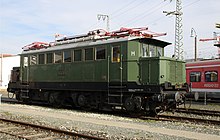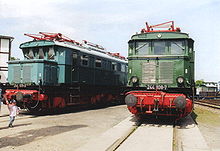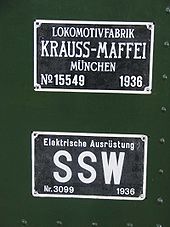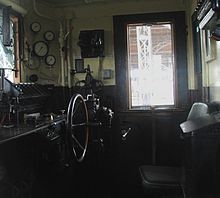DR series E 44
| DR series E 44 DB series 144, DR series 244 |
|
|---|---|
|
E44 046 as a memorial in Leipzig Hbf
|
|
| Numbering: | E 44 002-189 |
| Number: | 187 |
| Manufacturer: | SSW (electrical part), Krauss-Maffei , Henschel & Sohn , WLF |
| Year of construction (s): | 1932-1945; 1950-1951; 1955 |
| Retirement: | 1984 (DB) 1991 (DR) |
| Axis formula : | Bo'Bo ' |
| Gauge : | 1435 mm ( standard gauge ) |
| Length over buffers: | 15 290 mm |
| Height: | 3 950 mm |
| Width: | 2,960 mm |
| Trunnion Distance: | 6300 mm |
| Bogie axle base: | 3500 mm |
| Total wheelbase: | 9 800 mm |
| Service mass: | 78.0 t |
| Wheel set mass : | 19.5 t |
| Top speed: | 90 km / h |
| Hourly output : | 2200 kW |
| Continuous output : | 1860 kW |
| Starting tractive effort: | 196 kN |
| Performance indicator: | 28.2 kW / t |
| Driving wheel diameter: | 1 250 mm |
| Power system : | 15 kV, 16⅔ Hz |
| Power transmission: | Overhead line |
| Number of traction motors: | 4th |
| Drive: | Paw camp |
| Type of speed switch: | Manually operated cam controller with additional transformer and fine control |
| Brake: | One-way air brake with direct-acting additional brake Kbr / K-GP m. Z .; one-sided braking of all wheels |
| Train heating: | electrical 1000 V, 16⅔ Hz (originally also 800 V, 16⅔ Hz) |
The E 44 series was the first electric locomotive series in Germany, of which more than 100 units were purchased. It also represents a milestone in the development of electric locomotives, as it was the first time that running axles were dispensed with on a larger main-line locomotive and that the paw-bearing drive , which had been successful for many years, was established. The locomotives designed as universal locomotives proved to be very robust and reliable and shaped rail traffic in the electrified networks of southern and central Germany from the 1930s to the 1980s.
history

The electric locomotives of the series E 44 (from 1968 series 144 at the DB and from 1970 series 244 at the DR ) were designed by Walter Reichel from 1930 and with their concept as a multi-purpose electric locomotive that could be harnessed to freight and passenger trains, regarded as a pioneering achievement. The first machines were put into service by the Deutsche Reichsbahn-Gesellschaft (DR) from 1932 after a pre-series locomotive (E 44 001) had been developed by Krauss-Maffei and Siemens-Schuckertwerke (SSW, electrical part) a year earlier and had been developed by DR was tried. The vehicles with the Bo'Bo ' wheel arrangement were the first German series electric locomotives with bogies without running axles and single-axle drive and were primarily intended for the newly electrified route from Augsburg via the Geislinger Steige to Stuttgart from 1933 .
The locomotives proved their worth there, so that more locomotives were delivered to all the important Bavarian, Central German and Silesian railway depots in which electric locomotives were stationed. E 44s were also temporarily stationed in Salzburg , but they were returned.
Until 1945 the locomotives were procured under the designation KEL 1 (war locomotive 1) because of their strategic military importance, increasingly using home building materials . A total of 174 machines were built, many of which, however, suffered a total loss due to acts of war and therefore had to be retired.
The locomotives stationed in East Germany had to be handed over to the USSR after the cessation of electrical operation as part of the reparations . The then modern E 44 (and E 94) were re-gauged there to 1524 mm and equipped with SA3 central buffer couplings. The bogie frames were not designed for both conversions, which resulted in a loss of stability. The German material was used to set up a test farm near Perm. In 1952, after this test operation was completed, 44 machines and two locomotives captured in Hirschberg / Silesia (today Jelenia Góra ) were returned in a desperate condition. The re-tracked machines reached the Raw Dessau , each dismantled in three parts, loaded onto flat wagons. The E 44 047 remained in the Soviet Union, was converted to direct current and used on the Moscow – Aleksandrov and Baku – Surachan routes. In 1953 the locomotive came to the College for Engineers of Rail Transport in Dnepropetrovsk for teaching and study purposes and was scrapped in 1967.
German Federal Railroad
The majority of the locomotives came to the Deutsche Bundesbahn . This even built seven locomotives, as it was forbidden to develop completely new locomotives under the occupation statute: 1950 the E 44 181, 1951 the E 44 182 and 183 and 1955 the E 44 184 to 187. In 1963 and 1965 they were converted E 244 11 and 22 (see section E 244 ) put into service as E 44 188 and 189. The DB had a total of 125 locomotives. The DB equipped several machines for push-pull train operation , indicated by a G after the locomotive number. The E 44 with electric brake were prepared by a W identified. These locomotives were u. a. used on the Höllentalbahn in the Black Forest . From 1968, the E 44 was renamed the 144 series with the introduction of the IT numbers at the DB. The locomotives with electric brakes were classified in the class 145.
The 144er of the DB were stationed in Aschaffenburg , Augsburg , Freiburg , Freilassing , Garmisch , Munich Hbf , Munich East , Nürnberg Hbf , Rosenheim , Stuttgart , Bamberg , Tübingen , Pressig-Rothenkirchen and Würzburg . Two machines, the 144 021 and 071, received the new DB paint variant in ocean blue-beige. On September 24, 1983, the 144 did their last scheduled service and in 1984 they were retired from the Würzburg depot.
Deutsche Reichsbahn (after 1947)
After working up the presented German Reichsbahn (DR) locomotives to 1960 returned to service, where she primarily in 1955 Leipzig and Halle were stationed, but also from Bw Magdeburg-Buckau were used, and in the 1980s up to Rostock , Schwerin and Wismar came. The processing was complicated because almost the entire set of drawings had to be handed in with the machines, but these had not been returned. The profound changes to the bogies had to be reversed, for which new cross members and wheel stars had to be installed.
To protect the superstructure , the DR limited the permissible speed to 75 km / h at times, depending on the mileage and state of wear. In the mid-1960s, all locomotives were painted red on the bogies below the green locomotive body , i.e. the bogie frame, traction motors, wheel sets and braking equipment. This should make it easier to recognize cracks, which was not unimportant due to the damage caused by the less gentle re-gauging. They were run as the class 244 from 1970 and were in service until the summer of 1991. Components for which no spare parts were available were replaced by ones from our own production, so the locomotives received main switch DAT 1 and pantograph RBS 58.
In the beginning, the E 44s were used in front of all trains; With the delivery of new machines better suited for higher speeds, they first migrated from the express train service, and in the 1980s also from the passenger train service to freight transport. In order to save diesel fuel, some 244s were also recently used in shunting services, although locomotives with a central driver's cab are better suited for this. At the end of 1986 the Deutsche Reichsbahn still owned 23 locomotives, on January 1, 1991 ten of them. With the decree of December 31, 1991 these were decommissioned except for the traditional locomotives. For example, the E 44 044 (when it was rebuilt after returning from the USSR, the company numbers of the E 44 044 and 063 were swapped, so that the E 44 044 is actually the E 44 063) remained operational as the works locomotive of Raw Dessau . Some locomotives were still in use as heating locomotives after 1991 , locomotive 244 104 stationed in the Wismar depot was even renumbered to 144 103 on January 1, 1992.
Locomotive data
The locomotives were 15,290 mm long and weighed 78.0 t . The drive took place via four peg bearing motors. The machines had 15 continuous speed levels. The continuous output was 1860 kW at 86 km / h .
variants
Class E 44 G, DB class 144
A short time after the end of the Second World War , it was necessary to restore locomotives that had largely been destroyed. From 1951 the repair shops got several E 44s back on the road and modernized them with electrically controlled switchgear. This enabled a remote control from the control trolley - Type code G as G eführt. Similar assemblies were used in the E 41 from 1956. These were used in the electrical network, later known as the Meridian , south of the Munich S-Bahn as well as on the electrified branch line from Traunstein to Ruhpolding. The planned use ended only a year before the general end of the machines last named as 144.
Class E 44W, DB class 145
The E 44s, which were equipped with an electric resistance brake, had a W after the locomotive number until 1962 ; from 1962 to 1968 a 1 was placed in front of the serial number. So the E 44 152W became the E 44 1152. Originally, all E 44s from serial number 152 were supposed to be equipped with the electric brake, in fact it was only installed in part of the last series. From 1968, the remaining 16 machines with this brake were given the EDP series designation 145 on the Deutsche Bundesbahn . The E 44 178 was the only one of these locomotives that remained with the Deutsche Reichsbahn in the GDR.
From 1997 the Deutsche Bahn AG used the number 145 again for a new type of locomotive, see DB class 145 .
Class E 44.5, DB class 144.5
| DR class E 44.5 DB class 144.5 |
|
|---|---|
|
144 502 in Freilassing
|
|
| Numbering: | E 44 102–109 E 44 502–509 (from 1938) |
| Number: | 8th |
| Manufacturer: | MSW , AEG |
| Year of construction (s): | 1933-1935 |
| Retirement: | 1983 |
| Axis formula : | Bo'Bo ' |
| Length over buffers: | 13 520 mm |
| Height: | 3950 mm / 4260 mm |
| Width: | 3190 mm |
| Trunnion Distance: | 5640 mm |
| Bogie axle base: | 1765 mm |
| Empty mass: | 79 t |
| Top speed: | 80 km / h |
| Hourly output : | 1600 kW / 2200 kW |
| Driving wheel diameter: | 1250 mm |
| Power system : | 15 kV, 16⅔ Hz |
| Power transmission: | Overhead line |
| Number of traction motors: | 4th |
| Drive: | Paw camp |
| Type of speed switch: | Fine regulator control |
| Brake: | Compressed air brake Kzbr, one-sided braking of all wheels |

For the steep route from Freilassing to Berchtesgaden , the DR put eight locomotives of the E 44.5 series into service in 1933 and 1934 due to its positive experience with the E 44 101 model locomotive delivered in 1931. E 44 102-109 was the first to be used as numbering for the eight series locomotives. In 1938 all nine locomotives were redrawn as E 44 501–509.
- Model locomotive E 44 501, 1600 kW
- first series: E 44 502–505, 1600 kW
- second series: E 44 506–509, 2200 kW
As with the E 44, all E 44.5 had a pawl bearing drive .
The locomotives differ among other things. a. due to missing stems and other bogies from the conventional E 44. Electrical assemblies were adopted in both series of the E 44.5.
The E 44 502–505 could be distinguished from the E 44 506–509 by a different shape of the bridge frame. On the E 44 502–505 this was straight and closed to the outside, on the E 44 506–509 it was trapezoidal and had recesses on the sides.
The pre-production locomotive E 44 501 was taken out of service in 1959 due to numerous deviations and survived until 1979 as a demonstration object of a teaching aid train that was re-tracked far away from its former main line.
The locomotive, completely battered by countless re-railing exercises, was in the Hamm depot in November 1979 as station car 60125 and was scrapped in the early 1980s. While the locomotive body was already similar to the first series (E 44 502–505), the bogies had a shorter wheelbase.
In 1968 the E 44.5 were redrawn as 144 502–509. The 144.5 also carried high-quality passenger trains until they were retired in 1983 and were also available for snow clearing services. The 144.5s were almost always at home in the Freilassing depot .
The E 44 502 is preserved as an exhibit in the Museum Lokwelt Freilassing .
The E 44 507, the last operational copy of the second series, belongs to the Nuremberg Transport Museum . This locomotive is on loan to TEV Thüringer Eisenbahnverein e. V. in the former Weimar depot.
The E 44 508 also belongs to the Nuremberg Transport Museum and has also been in the Freilassing Lokwelt since June 22, 2008.
Series E 244
In 1936, the Deutsche Reichsbahn-Gesellschaft electrified the Höllentalbahn in the Black Forest with 20 kV and 50 Hertz for test purposes. In 1936 it put four locomotives developed on the basis of the E 44 and designed for this power system with different equipment into service (E 244 01, 11, 21 and 31). They were given the series number E 244 and were designed for a top speed of 85 km / h on the flat and 60 km / h on the steep section.
- The E 244 01 was the first locomotive in the world to have a grid-controlled mercury vapor rectifier . A phase control was thus represented. Your traction motors were fed with direct current via this rectifier and a smoothing choke . The rectifier was connected to the transformer in a mid-point circuit, with two anodes for each polarity. One anode was connected to the full transformer voltage and one tap with a lower voltage. In addition, the traction motors could be operated in parallel and in series. The mechanical part of it was derived from the E 44 5 series (second series E 244 506-509 with openwork solebars) and, in contrast to the other versions of the E 244 series, had no front stems.
- The E 244 11 had an uncontrolled mercury vapor rectifier. It was controlled by a switching mechanism on the high-voltage side of the transformer. The traction motors of this locomotive were fed with the pulsating direct current generated by this rectifier.
- The E 244 21 and the E 244 22 - built after the Second World War from the war-damaged E 44 005 - had a drive by means of commutator motors, which were directly supplied with 50 Hertz alternating current via the transformer with secondary switching mechanism. These motors were characterized by a very complex commutator construction. By March 1948, the E 244 21 served as a test vehicle on the French railway line Aix-les-Bains-Annemasse , in October 1951, the E 244 22 came a short time there used.
- The E 244 31 had a special type of single-phase asynchronous motor as its drive motor.
All E 244s supplied the train heating with the 1000 and 800 volts, which were common in Germany at the time, with a frequency of 50 Hertz corresponding to the contact wire voltage.
In 1960 the power supply of the Höllentalbahn was switched to the usual 15 kV with 16⅔ Hertz.
- The E 244 01 was scrapped.
- The E 244 21 was rebuilt and ran under the designation E 344 01 , later 183 001, as a two-frequency locomotive for 15 and 25 kV on SNCF lines .
- The E 244 11 and 22 were converted into normal E 44 (E 44 188 and 189). Outwardly, they were noticeable through only two rubber-framed front windows and side nozzle grilles.
- The E 244 31 came to the Deutsches Museum in 1962, and from 1969 it belonged to the University of Karlsruhe. In 2003 she came on loan to the Mannheim Historical Railway.
Whereabouts
Of the 187 copies built, some E 44s have been preserved in museums .
- The E 244 31 is now in the care of the Historischen Eisenbahn Mannheim e. V.
- The E 44 001 and 508 are owned by the Nuremberg Transport Museum . After the construction of a temporary track, the E 44 508 was transferred by rail to the Freilassing locomotive world on June 21, 2008.
- The former Reichsbahn locomotive 244 051 is also in Freilassing.
- The E 44 502 is located in Traunstein , but was also seen as a memorial in July 2008 as 144 502 in Freilassing.
- The E 44 046 can also be seen on the museum track at Leipzig Central Station.
- The E 44 002 is located in the DB Museum Koblenz . The E 44 131 is also in its last operating state as 244 131 in the German Museum of Technology in Berlin .
- The E 44 084 is on display in the SVG Eisenbahn-Erlebniswelt Horb am Neckar (loan from the DB Museum) and has been repainted in the original colors.
- The Saxon Railway Museum Chemnitz-Hilbersdorf is home to the E 44 045.
- The 244 137 stood until 2013 with dismantled pantographs and in poor condition in the abandoned locomotive depot in Franzensfeste (Italy). In 2014 it was transferred to the South German Railway Museum in Heilbronn .
- The E 44 108 is located in the DB Museum Halle (Saale) .
- The E 44 148 is in the private Hermeskeil Steam Locomotive Museum .
- In addition, the E 44 044, 049, 103, 137, 139 and 146 have been preserved.
- The E 44 059 had been standing together with the 1180 since 2002 in the old Worms depot, which burned out on November 8, 2019. Both were used as spare parts dispensers (E 44 059 → E 44 119; E 44 1180 → E 44 1170) and are no longer completely preserved.
Before leaving in August 1983, the E 44 1170 had served in Freiburg, Rosenheim and Würzburg. In 1984 it was purchased and looked after as an exhibit by a leisure group of the Bahn-Sozialwerk Foundation in Freiburg im Breisgau for the Freiburg railway anniversary in the following year. Until the main inspection was due in 1996, the machine was then used once a month for the Höllental and Dreiseenbahn as well as for some special trips. The locomotive was kept in the Freiburg depot until it was put outside after its renovation in 2000 due to lack of space. In May 2002 it was taken over by the Betzdorf Railway Friends, who from then on exhibited it in the South Westphalian Railway Museum in Siegen . Since summer 2010 it has been back in its old home in the care of IG 3-Seenbahn eV The locomotive has a drive motor damaged, but is otherwise in good condition. In the Upper Black Forest, it is to be made operational over the next few years and given a general inspection.
literature
- German old-style electric locomotive. Part 1–2. EK Verlag, Freiburg (Breisgau) 1993–1994 ( Eisenbahn-Kurier , Special. Nos. 28 and 32).
- Brian Rampp: The class E 44. The trend-setting series locomotives of the SSW type. EK-Verlag, Freiburg (Breisgau) 2009, ISBN 978-3-88255-206-5 ( Eisenbahn-Kurier ).
Web links
- E 44 in the locomotive lexicon
- E 44 on the Höllentalbahn
- E44 of the Höllental route near Nahverkehr-Breisgau
- Information on the preserved E 44 series locomotives on the "Railway Museum Vehicles" website
Series E 244
- Brief profile on www.elektrolok.de
Individual evidence
- ^ Siemens AG: "125 Years of the Electric Railway" ( Memento from January 22, 2015 in the Internet Archive )
- ^ Archive of the TU Berlin
- ↑ Andreas Knipping: The farewell of the veterans . In: Eisenbahn Magazin . No. 2 , 2016, p. 45 .
- ↑ Brian Rampp: Use in Hell Valley . In: Electric locomotives. E 41/141 to E 244 . GeraMond, Munich 2019, ISBN 978-3-7654-7528-3 , pp. 91 ff .
- ↑ E 244 31 ( Memento from September 29, 2007 in the Internet Archive ) on the website of the historic railway Mannheim
- ↑ Electric passenger locomotive E 44 137 , www.eisenbahn-museumsfahrzeuge. Retrieved April 14, 2015.
- ↑ Class E 44 dampflokmuseum-hermeskeil.de Retrieved on December 5, 2019.
- ↑ Andreas Knipping: The farewell of the veterans . In: Eisenbahn Magazin . No. 2 , 2016, p. 45 .
- ↑ Worms: Old locomotive hall burned out - tracks partially blocked Die Rheinpfalz, accessed on April 26, 2020
- ^ Freiburger-Minidampfbahn.de: About our BSW group ( Memento from May 23, 2010 in the Internet Archive ) . Retrieved December 18, 2009.
- ↑ E44 1170 , www.3seenbahn.de, accessed on May 3, 2020









